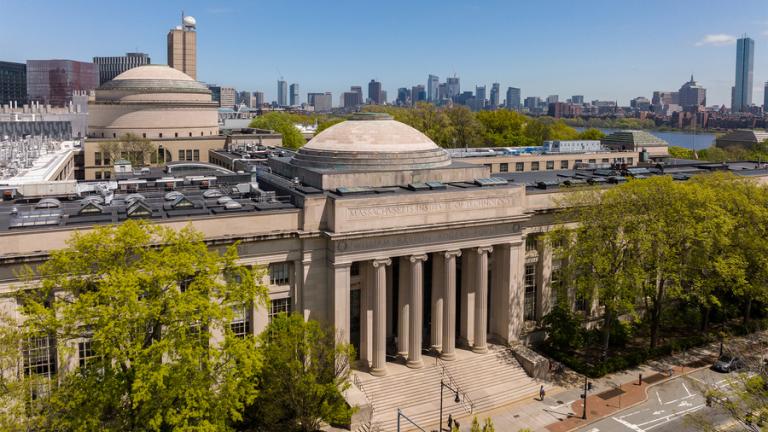
MIT and GE Vernova today announced the creation of the MIT-GE Vernova Energy and Climate Alliance to help develop and scale sustainable energy systems across the globe.
The alliance launches a five-year collaboration between MIT and GE Vernova, a global energy company that spun off from General Electric’s energy business in 2024. The endeavor will encompass research, education, and career opportunities for students, faculty, and staff across MIT’s five schools and the MIT Schwarzman College of Computing. It will focus on three main themes: decarbonization, electrification, and renewables acceleration.
“This alliance will provide MIT students and researchers with a tremendous opportunity to work on energy solutions that could have real-world impact,” says Anantha Chandrakasan, MIT’s chief innovation and strategy officer and dean of the School of Engineering. “GE Vernova brings domain knowledge and expertise deploying these at scale. When our researchers develop new innovative technologies, GE Vernova is strongly positioned to bring them to global markets.”
Through the alliance, GE Vernova is sponsoring research projects at MIT and providing philanthropic support for MIT research fellowships. The company will also engage with MIT’s community through participation in corporate membership programs and professional education.
“It’s a privilege to combine forces with MIT’s world-class faculty and students as we work together to realize an optimistic, innovation-driven approach to solving the world’s most pressing challenges,” says Scott Strazik, GE Vernova CEO. “Through this alliance, we are proud to be able to help drive new technologies while at the same time inspire future leaders to play a meaningful role in deploying technology to improve the planet at companies like GE Vernova.”
“This alliance embodies the spirit of the MIT Climate Project — combining cutting-edge research, a shared drive to tackle today’s toughest energy challenges, and a deep sense of optimism about what we can achieve together,” says Sally Kornbluth, president of MIT. “With the combined strengths of MIT and GE Vernova, we have a unique opportunity to make transformative progress in the flagship areas of electrification, decarbonization, and renewables acceleration.”
The alliance, comprising a $50 million commitment, will operate within MIT’s Office of Innovation and Strategy. It will fund approximately 12 annual research projects relating to the three themes, as well as three master’s student projects in MIT’s Technology and Policy Program. The research projects will address challenges like developing and storing clean energy, as well as the creation of robust system architectures that help sustainable energy sources like solar, wind, advanced nuclear reactors, green hydrogen, and more compete with carbon-emitting sources.
The projects will be selected by a joint steering committee composed of representatives from MIT and GE Vernova, following an annual Institute-wide call for proposals.
The collaboration will also create approximately eight endowed GE Vernova research fellowships for MIT students, to be selected by faculty and beginning in the fall. There will also be 10 student internships that will span GE Vernova’s global operations, and GE Vernova will also sponsor programming through MIT’s New Engineering Education Transformation (NEET), which equips students with career-oriented experiential opportunities. Additionally, the alliance will create professional education programming for GE Vernova employees.
“The internships and fellowships will be designed to bring students into our ecosystem,” says GE Vernova Chief Corporate Affairs Officer Roger Martella. “Students will walk our factory floor, come to our labs, be a part of our management teams, and see how we operate as business leaders. They’ll get a sense for how what they’re learning in the classroom is being applied in the real world.”
Philanthropic support from GE Vernova will also support projects in MIT’s Human Insight Collaborative (MITHIC), which launched last fall to elevate human-centered research and teaching. The projects will allow faculty to explore how areas like energy and cybersecurity influence human behavior and experiences.
In connection with the alliance, GE Vernova is expected to join several MIT consortia and membership programs, helping foster collaborations and dialogue between industry experts and researchers and educators across campus.
With operations across more than 100 countries, GE Vernova designs, manufactures, and services technologies to generate, transfer, and store electricity with a mission to decarbonize the world. The company is headquartered in Kendall Square, right down the road from MIT, which its leaders say is not a coincidence.
“We’re really good at taking proven technologies and commercializing them and scaling them up through our labs,” Martella says. “MIT excels at coming up with those ideas and being a sort of time machine that thinks outside the box to create the future. That’s why this such a great fit: We both have a commitment to research, innovation, and technology.”
The alliance is the latest in MIT’s rapidly growing portfolio of research and innovation initiatives around sustainable energy systems, which also includes the Climate Project at MIT. Separate from, but complementary to, the MIT-GE Vernova Alliance, the Climate Project is a campus-wide effort to develop technological, behavioral, and policy solutions to some of the toughest problems impeding an effective global climate response.






